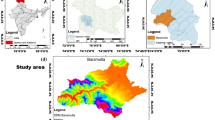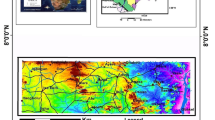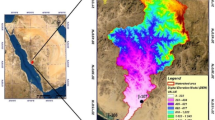Abstract
Despite its potential for drinking, domestic/non-domestic use, and agricultural development in Ethiopia, groundwater is underutilized. By employing a geospatial tools analytical hierarchy approach and statistical models, this study evaluated the potential groundwater zone of the Mensa River watershed in the Omo River Valley, Ethiopia. This study identified seven significant groundwater potential influencing parameters and mapped them based on remote sensing, field and secondary data: geology, lineament density, land use/land cover, slope, drainage density, soil type, and rainfall. Based on the significance of the seven thematic maps as judged by professional judgment and a review of the pertinent literature, weights were assigned to each in the AHP model. The weighted thematic factors were integrated to create a composite map of potential groundwater zones using a weighted linear combination approach. According to the results of the analytical hierarchy process models, 7% and 21% of the research region contain zones with very high and high groundwater potential, respectively. This zone consists of low drainage, high lineament, and medium trachyte rocks in the study area's central, western, and southern regions. An analysis of the spatial relationships between well/spring sites and seven groundwater conditioning parameters was conducted using a frequency ratio model. According to the frequency ratio model, 4% and 10% of the research area have very high and high groundwater potentials, primarily in the northern and northwest regions, with limited coverage in the centre. Using the area under-curve approach, the analytical hierarchy process and frequency ratio models identified likely groundwater zones with 70.5% and 60% accuracy. According to the sensitivity analysis results, groundwater’s potential relies mainly on LU/LC, precipitation, and soil type. The integrated approach of the present study's outcome may be helpful for hydrogeologists, planners, and administrators in the study area for managing groundwater resources sustainably.














Similar content being viewed by others
References
Abdulkerim E, Fufa F, Takala W (2022) Identification of groundwater recharge site using geographical information system and remote sensing: case study of Sude district, Oromia, Ethiopia. Environ Earth Sci 81(2):1–15
Ahmed N, Hoque M-A, Pradhan B, Alireza D (2021) Spatio-temporal assessment of groundwater potential zone in the drought-prone area of bangladesh using GIS-based bivariate models. Nat Resour Res 30(5):3315–3337
Akinlalu AA, Adegbuyiro A, Adiat KAN, Akeredolu BE, Lateef WY (2017) Application of multi-criteria decision analysis in prediction of groundwater resources potential: a case of Oke-Ana, Ilesa area Southwestern, Nigeria. NRIAGJ Astron Geophys 6:184–200
Al-Abadi A, Al-Shamma’a A (2014) Groundwater potential map** of the major aquifer in Northeastern Missan Governorate, South of Iraq by using analytical hierarchy process and GIS. J Environ Earth Sci 10:125–149
Allafta H, Opp C, Patra S (2021) Identification of groundwater potential zones using remote sensing and GIS techniques: a case study of the Shatt Al-Arab Basin. Remote Sens 13(1):112. https://doi.org/10.3390/rs13010112
Amponsah PO, Forson ED, Sungzie PS (2022) Groundwater prospectivity modeling over the Akatsi Districts in the Volta Region of Ghana using the frequency ratio technique. Model Earth Syst Environ. https://doi.org/10.1007/s40808-022-01539-8
Andualem TG, Demeke GG (2019) Groundwater potential assessment using GIS and remote sensing: a case study of Guna tana landscape, upper blue Nile Basin, Ethiopia. J Hydrol Reg Stud 24:100610. https://doi.org/10.1016/j.ejrh.2019.100610
Anteneh ZS, Awoke BG, Reda TM (2022) Groundwater potential map** using integrations of remote sensing and analytical hierarchy process methods in Ataye-watershed, Middle Awash Basin, Ethiopia. Sustain Water Resour Manag 8:183. https://doi.org/10.1007/s40899-022-00772-4
Arefin R (2020) Groundwater potential zone identification using an analytic hierarchy process in Dhaka City, Bangladesh. Environ Earth Sci 79:268. https://doi.org/10.1007/s12665-020-09024-0
Birkett C, Murtugudde R, Allan T (1999) Indian Ocean climate event brings floods to East Africa’s lakes and the Sudd Marsh. Geophys Res Lett 26(8):1031–1034
Dar T, Rai N, Bhat A (2021) Delineation of potential groundwater recharge zones using analytical hierarchy process (AHP). Geol Ecol Landsc 5(4):292–307
Das N, Mukhopadhyay S (2018) Application of multi-criteria decision making technique for the assessment of groundwater potentialzones: a study on Birbhum district, West Bengal, India. Environ Environ Dev Sustain 22:931–955. https://doi.org/10.1007/s10668-018-0227-7
Deepa S, Venkateswaran S, Ayyandurai R, Kannan R, Vijay Prabhu M (2016) Groundwater recharge potential zones map** in upper Manimuktha Sub basin Vellar river Tamil Nadu India using GIS and remote sensing techniques. Model Earth Syst Environ 2(3):1–13. https://doi.org/10.1007/s40808-016-0192-9
Etuk MN, Igwe O, Egbueri JC (2022) An integrated geoinformatics and hydrogeological approach to delineating groundwater potential zones in the complex geological terrain of Abuja, Nigeria. Model Earth Syst Environ. https://doi.org/10.1007/s40808-022-01502-7
Fildes SG, Clark IF, Somaratne NM, Ashman G (2020) Map** groundwater potential zones using remote sensing and geographical information systems in a fractured rock setting, Southern Flinders Ranges, South Australia. J Earth Syst Sci 129(1):160
Ganapuram S, Nagarajan R, Sehkar G, Balaji V (2015) Spatio-temporal analysis of droughts in the semi-arid Pedda Vagu and Ookacheti Vagu watersheds, Mahabubnagar District, India. Arab J Geosci 8:6911–6929. https://doi.org/10.1007/s12517-014-1696-0
Gebeyohannes T, De Smedt F, Walraevens K, Gebresilassie S, Hussien A, Hagos M, Gebrehiwot K (2013) Application of a spatially distributed water balance model for assessing surface water and groundwater resources in the Geba basin, Tigray. Ethiopia J Hydrol 499:110–123. https://doi.org/10.1016/j.jhydrol.2013.06.026
Golla V (2020) Delineation of groundwater potential zones in Sathyavedu area, Chittoor District (Andhra Pradesh), South India, using geospatial technologies. Model Earth Syst Environ 6:895–905. https://doi.org/10.1007/s40808-020-00726-9
Goswami T, Ghosal S (2022) Understanding the suitability of two MCDM techniques in map** the groundwater potential zones of semi-arid Bankura District in eastern India. Groundw Sustain Dev 17:100727. https://doi.org/10.1016/j.gsd.2022.100727
GSE (2016) Integrated hydrogeological and hydrochemical map** of dime map sheet (NB 37-5). Available online: https://gis.gse.gov.et/hg-maps/
GSE (2018) Geology, geochemistry and gravity survey of dime map sheet (NB 37-5)
Guru B, Sheshan K, Bera S (2017) Frequency ratio model for groundwater potential map** and its sustainable management in cold desert, India. J King Saud Univ Sci 29(3):333–347
Hosseinali F, Alesheikh AA (2008) Weighting spatial information in GIS for copper mining exploration. Am J Appl Sci 5(9):1187–1198
Ibrahim-Bathis K, Ahmed SA (2016) Geospatial technology for delineating groundwater potential zones in Doddahalla watershed of Chitradurga district, India. Egypt J Remote Sens Space Sci 19(2):223–234. https://doi.org/10.1016/j.ejrs.2016.06.002
Jaiswai RK, Mukherjee S, Krishnamurthy J, Saxena R (2003) Role of remote sensing and GIS techniques for generation of groundwater prospect zones towards rural development-an approach. Int J Remote Sens 24(5):993–1008. https://doi.org/10.1080/01431160210144543
Kirubakaran M, Johnny JC, Ashokraj C, Arivazhagan S (2016) A geostatistical approach for delineating the potential groundwater recharge zones in the hard rock terrain of Tirunelveli taluk, Tamil Nadu, India. Arab J Geosci 9(5):1–16. https://doi.org/10.1007/s12517-016-2419-5
Kouamou Njifen SR, Enyegue A, Nyam FM, Bikoro MBA, Anita TN, Charles TT (2022) Modeling groundwater potential zones in the Kribi-Campo region, South Cameroon using geospatial techniques and statistical models. Model Earth Syst Environ. https://doi.org/10.1007/s40808-022-01544-x
Kumar A, Krishna AP (2016) Assessment of groundwater potential zones in coal mining impacted hard-rock terrain of India by integrating geospatial and analytic hierarchy process (AHP) approach. Geocarto Int 33(2):105–129. https://doi.org/10.1080/10106049.2016.1232314
Kumar M, Singh P, Singh P (2021) Fuzzy AHP based GIS and remote sensing techniques for the groundwater potential zonation for Bundelkhand Craton Region, India. Geocarto Int 37(22):6671–6694. https://doi.org/10.1080/10106049.2021.1946170
Kumar M, Singh SK, Kundu A, Krishan T, Jagadeesh M, Alex F, Aditya R, Deepak L (2022) GIS-based multi-criteria approach to delineate groundwater prospect zone and its sensitivity analysis. Appl Water Sci 12:71. https://doi.org/10.1007/s13201-022-01585-8
Kumari A, Dhanaraj G (2021) Groundwater potential zone map** through an integrated approach of GIS and AHP in Lalganj tehsil of Mirzapur district, Uttar Pradesh, India. Arab J Geosci 14(21):1–15. https://doi.org/10.1007/s12517-021-08550-w
Kumari S, Poddar A, Kumar N, Shankar V (2022) Delineation of groundwater recharge potential zones using the modeling based on remote sensing, GIS and MIF techniques: a study of Hamirpur District, Himachal Pradesh, India. Model Earth Syst Environ 8:1759–1770. https://doi.org/10.1007/s40808-021-01181-w
Lentswe GB, Molwalefhe L (2020) Delineation of potential groundwater recharge zones using analytic hierarchy process-guided GIS in the semi-arid Motloutse watershed, eastern Botswana. J Hydrol Reg Stud. https://doi.org/10.1016/j.ejrh.2020.100674
Magesh NS, Chandrasekar N, Soundranayagam JP (2012) Delineation of groundwater potential zones in Theni district, Tamil Nadu, using remote sensing, GIS and MIF Techniques. Geosci Front 3(2):189–196. https://doi.org/10.1016/j.gsf.2011.10.007
Mageshkumar P, Subbaiyan A, Lakshmanan E, Thirumoorthy P (2019) Application of geospatial techniques in delineating groundwater potential zones: a case study from South India. Arab J Geosci 12:151. https://doi.org/10.1007/s12517-019-4289-0
Maity B, Mallick SK, Das P, Rudra S (2022) Comparative analysis of groundwater potentiality zone using fuzzy AHP, frequency ratio and Bayesian weights of evidence methods. Appl Water Sci 12(4):1–16. https://doi.org/10.1007/s13201-022-01591-w
Manap MA, Nampak H, Pradhan B, Lee S, Sulaiman WA, Ramli MF (2014) Application of probabilistic-based frequency ratio model in groundwater potential map** using remote sensing data and GIS. Arab J Geosci 7(2):711–724. https://doi.org/10.1007/s12517-012-0795-z
Moges DM, Bhat HG, Thrivikramji KP (2019) Investigation of groundwater resources in highland Ethiopia using a geospatial technology. Model Earth Syst Environ 5:1333–1345. https://doi.org/10.1007/s40808-019-00603-0
Mukherjee P, Singh CK, Mukherjee S (2012) Delineation of groundwater potential zones in arid region of India—a remote sensing and GIS approach. Water Resour Manag 26(9):2643–2672. https://doi.org/10.1007/s11269-012-0038-9
Muralitharan J, Palanivel K (2015) Groundwater targeting using remote sensing, geographical information system and analytical hierarchy process method in hard rock aquifer system, Karur district, Tamil Nadu, India. Earth Sci Inform 8:827–842. https://doi.org/10.1007/s12145-015-0213-7
Nag SK, Ray S (2015) Deciphering groundwater potential zones using geospatial technology: a study in Bankura Block I and Block II, Bankura District, West Bengal. Arab J Sci Eng 40(1):205–214. https://doi.org/10.1007/s13369-014-1511-y
Naghibi SA, Pourghasemi HR, Pourtaghi ZS, Rezaei A (2015) Groundwater qanat potential map** using frequency ratio and Shannon’s entropy models in the Moghan watershed, Iran. Earth Sci Inform 8:171–186. https://doi.org/10.1007/s12145-014-0145-7
Naghibi SA, Pourghasemi HR, Dixon B (2016) GIS-based groundwater potential map** using boosted regression tree, classification and regression tree, and random forest machine learning models in Iran. Environ Monit Assess 188(1):1–27. https://doi.org/10.1007/s10661-015-5049-6
Oh HJ, Kim YS, Choi JK, Park E, Lee S (2011) GIS map** of regional probabilistic groundwater potential in the area of Pohang City. Korea J Hydrol 399(3–4):158–172. https://doi.org/10.1016/j.jhydrol.2010.12.027
Omosuyi GO, Oshodi DR, Sanusi SO, Adeyemo LA (2021) Groundwater potential evaluation using geoelectrical and analytical hierarchy process modeling techniques in Akure-Owode, southwestern Nigeria. Model Earth Syst Environ 7:145–158. https://doi.org/10.1007/s40808-020-00915-6
Ozdemir A (2011) GIS-based groundwater spring potential map** in the Sultan Mountains (Konya, Turkey) using frequency ratio, weights of evidence and logistic regression methods and their comparison. J Hydrol 411(3–4):290–308. https://doi.org/10.1016/j.jhydrol.2011.10.010
Panahi RM, Mousavi SM, Rahimzadegan M (2017) Delineation of groundwater potential zones using remote sensing, GIS, and AHP technique in Tehran-Karaj plain, Iran. Environ Earth Sci. https://doi.org/10.1007/s12665-017-7126-3
Patra S, Mishra P, Mahapatra SC (2018) Delineation of groundwater potential zone for sustainable development: a case study from Ganga Alluvial Plain covering Hooghly district of India using remote sensing, geographic information system and analytic hierarchy process. J Clean Prod 172:2485–2502. https://doi.org/10.1016/j.jclepro.2017.11.161
Pinto D, Shrestha S, Babel MS, Ninsawat S (2017) Delineation of groundwater potential zones in the Comoro watershed, Timor Leste using GIS, remote sensing and analytic hierarchy process (AHP) technique. Appl Water Sci 7(1):503–519. https://doi.org/10.1007/s13201-015-0270-6
Pourtaghi ZS, Pourghasemi HR (2014) GIS-based groundwater spring potential assessment and map** in the Birjand Township, southern Khorasan Province. Iran Hydrogeol J 22(3):643–662. https://doi.org/10.1007/s10040-013-1089-6
Qadir J, Bhat MS, Rashid I (2020) Map** groundwaterpotential zones using remote sensing and GIS approach in Jammu Himalaya, Jammu and Kashmir. GeoJournal 85(2):487–504. https://doi.org/10.1007/s10708-019-09981-5
Rahmati O, Nazari SA, Mahdavi M, Pourghasemi HR, Zeinivand H (2015) Groundwater potential map** at Kurdistan region of Iran using analytic hierarchy process and GIS. Arab J Geosci 8(9):7059–7071. https://doi.org/10.1007/s12517-014-1668-4
Roy S, Sahu AS (2015) Investigation for potential groundwater recharge area over the Kunur river basin, Eastern India: an integrated approach with geosciences. J Geomat 9(2):165–177
Roy S, Bose A, Mandal G (2022) Modeling and map** geospatial distribution of groundwater potential zones in Darjeeling Himalayan region of India using analytical hierarchy process and GIS technique. Model Earth Syst Environ 8:1563–1584. https://doi.org/10.1007/s40808-021-01174-9
Saaty TL (1980) The analytic hierarchy process: planning, priority setting, resource allocation. McGraw, New York, p 281
Saaty TL (2001) Decision making for leaders: the analytic hierarchy process for decisions in a complex world. RWS publications, Pittsburgh
Sachdeva S, Kumar B (2021) Comparison of gradient boosted decision trees and random forest for groundwater potential map** in Dholpur (Rajasthan), India. Stoch Environ Res Risk Assess 35:287–306. https://doi.org/10.1007/s00477-020-01891-0
Sahoo S, Jha MK, Kumar N, Chowdary VM (2015) Evaluation of GIS-based multicriteria decision analysis and probabilistic modeling for exploring groundwater prospects. Environ Earth Sci 74(3):2223–2246. https://doi.org/10.1007/s12665-015-4213-1
Salui CL (2018) Methodological validation for automated lineament extraction by LINE Method in PCI geomatica and MATLAB based hough transformation. J Geol Soc India 92:321–328. https://doi.org/10.1007/s12594-018-1015-6
Saravanan S, Saranya T, Jennifer JJ, Singh L, Selvaraj A, Abijith D (2020) Delineation of groundwater potential zone using analytical hierarchy process and GIS for Gundihalla watershed Karnataka, India. Arab J Geosci 13:695. https://doi.org/10.1007/s12517-020-05712-0
Saravanan S, Saranya T, Abijith D (2021) Application of frequency ratio, analytical hierarchy process, and multi-infuencing factor methods for delineating groundwater potential zones. Int J Environ Sci Technol 19:12211–12234. https://doi.org/10.1007/s13762-021-03794-1
Senapati U, Das TK (2021) Assessment of basin-scale groundwater potentiality map** in drought-prone upper Dwarakeshwar River basin, West Bengal, India, using GIS-based AHP techniques. Arab J Geosci 14:960. https://doi.org/10.1007/s12517-021-07316-8
Singh P, Gupta A, Singh M (2014) Hydrological inferences from watershed analysis for water resource management using remote sensing and GIS techniques. Egypt J Remote Sens Scape Sci 17(2):111–121. https://doi.org/10.1016/j.ejrs.2014.09.003
Singh LK, Jha MK, Chowdary VM (2018) Assessing the accuracy of GIS-based multi-criteria decision analysis approaches for map** groundwater potential. Ecol Indic 91:24–37. https://doi.org/10.1016/j.ecolind.2018.03.070
Tanveer D, Nachiketa R, Aadil B (2021) Delineation of potential groundwater recharge zones using analytical hierarchy process (AHP). Geol Ecol Landsc 5(4):292–307. https://doi.org/10.1080/24749508.2020.1726562
Teshome A, Halefom A, Ahmad I, Teshome M (2021) Fuzzy logic techniques and GIS-based delineation of groundwater potential zones: a case study of Anger river basin, Ethiopia. Model Earth Syst Environ 7:2619–2628. https://doi.org/10.1007/s40808-020-01035-x
Tiwari AK, Lavy M, Amanzio G, De Maio M, Singh PK, Mahato MK (2017) Identification of artificial groundwater recharging zone using a GIS-based fuzzy logic approach: a case study in a coal mine area of the Damodar Valley, India. Appl Water Sci 7(8):4513–4524. https://doi.org/10.1007/s13201-017-0603-8
Valverde JPB, Blank C, Roid M, Shchneider L, Stefan C (2016) Application of a GIS multi-criteria decision analysis for the identification of intrinsic suitable sites in costa rica for the application of managed aquifer recharge (MAR) through spreading methods. Water 8(9):391. https://doi.org/10.3390/w8090391
Vu VH, Merkel BJ (2019) Estimating groundwater recharge for Hanoi, Vietnam. Sci Total Environ 651:1047–1057. https://doi.org/10.1016/j.scitotenv.2018.09.225
Worqlul AW, Jeong J, Dile YT, Osorio J, Schmitter P, Gerik T, Clark N (2017) Assessing potential land suitable for surface irrigation using groundwater in Ethiopia. Appl Geogr 85:1–13. https://doi.org/10.1016/j.apgeog.2017.05.010
Author information
Authors and Affiliations
Corresponding author
Ethics declarations
Conflict of interest
The authors declare that there is no conflict of interest.
Additional information
Publisher's Note
Springer Nature remains neutral with regard to jurisdictional claims in published maps and institutional affiliations.
Rights and permissions
Springer Nature or its licensor (e.g. a society or other partner) holds exclusive rights to this article under a publishing agreement with the author(s) or other rightsholder(s); author self-archiving of the accepted manuscript version of this article is solely governed by the terms of such publishing agreement and applicable law.
About this article
Cite this article
Genjula, W., Jothimani, M., Gunalan, J. et al. Applications of statistical and AHP models in groundwater potential map** in the Mensa river catchment, Omo river valley, Ethiopia. Model. Earth Syst. Environ. 9, 4057–4075 (2023). https://doi.org/10.1007/s40808-023-01765-8
Received:
Accepted:
Published:
Issue Date:
DOI: https://doi.org/10.1007/s40808-023-01765-8




